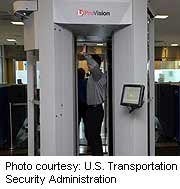
MONDAY, March 28 (HealthDay News) — Radiation from the full-body scanners increasingly used to screen U.S. airline passengers is not a significant health threat, University of California researchers report.
Health concerns have arisen since the U.S. Transportation Safety Administration (TSA) installed full-body scanners as a counter-terrorism tactic. The TSA now operates 486 scanners in 78 U.S. airports, and it plans to have about 1,000 in use by the end of the year, the researchers say. Backscatter X-ray devices are the more common — and more controversial — of the two types of scanning devices.
“The doses delivered by the airport backscatter scanners is truly very low, and individuals should not fear going through the scanners based on exposure to the radiation,” said study co-author Dr. Rebecca Smith-Bindman, a professor in residence in the departments of radiology, epidemiology/biostatistics, and obstetrics, gynecology, and reproductive medicine at the University of California, San Francisco.
“Despite being ionizing radiation, the doses are not that different than the doses we are exposed to every day from daily living,” she added. The scanner emits about three to nine minutes of the radiation received through normal daily living, the study found.
The study supports other recent reports that found frequent fliers will not be subject to excessive radiation. Compared with medical imaging devices, the authors say a passenger would need 50 airport scans to receive the radiation delivered by a dental X-ray or 1,000 scans to obtain the radiation provided by a chest X-ray. Four thousand body scans would achieve the dose delivered by one mammogram, and 20,000 scans would be comparable to a pelvic and abdominal CT scan, say Smith-Bindman and study co-author Pratik Mehta, of the University of California, Berkeley.
The image revealed by backscatter scanners comes from radiation reflected off a body, whereas medical imaging machines transmit radiation through the body, the authors explain.
For their study, published online March 28 in the Archives of Internal Medicine, Smith-Bindman and Mehta looked at three groups: all fliers, frequent fliers (those who fly 60 or more hours a week) and 5-year-old girls who fly weekly. This last group was included because children are more sensitive to radiation.
They assumed that all passengers would have a full-body scan on each trip, receiving radiation exposure of 0.1µSv (microsievert), with 100 million passengers taking 750 million flights in a year.
Among passengers on all these flights, they estimated that six cancers could develop over a lifetime from scanner radiation. But, some 40 million cancers would result from other causes in those fliers, the authors say.
For frequent fliers, four cancers might be linked to these scanners, but 600 cancers would result from flying at high altitudes, and 400,000 cancers would develop because of other factors, the researchers noted.
Among 2 million 5-year-old girls making one round-trip a week, airport scanners might cause one additional breast cancer over their lifetimes, but 250,000 breast cancers would result from other causes in this group, the researchers said.
“Based on what is known about the scanners, passengers should not fear going through the scans for health reasons, as the risks are truly trivial. If individuals feel vulnerable and are worried about the radiation emitted by the scans, they might reconsider flying altogether since most of the small, but real, radiation risk they will receive will come from the flight and not from the exceedingly small exposures from the scans,” Smith-Bindman and Mehta write.
Still, they note that additional testing of the devices would be prudent.
Another expert, Dr. Stephen Machnicki, associate chairman of the department of radiology at Lenox Hill Hospital in New York City, agrees the radiation doses from these scanners are safe.
“People are exposed to much more radiation from the sun, radon from the ground, radiation from industry and medical scanning than from these scanners,” he said. “Of course, no radiation is better than radiation, but you have to weigh the pros and cons. I don’t think the risks from these scanners is so great people should be hysterical about it and have this fear that prevents them from flying.”
However, radiation expert Peter Rez, a professor of physics at Arizona State University in Tempe, found shortcomings in the study.
“I think they are correct that the radiation dose from the scanner is less than the radiation from the average flight, though I believe their numbers might be a factor of 10 too low,” he said. “The real danger is what happens if the scans fail and there is a very high local dose,” Rez said.
The key issue, said Rez, is this: “Is the risk, however small, worth it?”
“The question is not how the four excess cancers and one excess breast cancer compare with other sources of cancer, but how they compare with the risk of being killed by terrorists in an airplane,” he said.
“According to my estimates, the risk from the scanner is low, about one in 30 million, the risk of dying from a terrorist attack on an airplane is equally low, if not lower, one in 30 million to one in 100 million,” Rez said.
The TSA also permits passengers who don’t want the body scan to undergo a physical pat-down.
More information
For more information on scanner safety, visit the U.S. Transportation Safety Administration.

